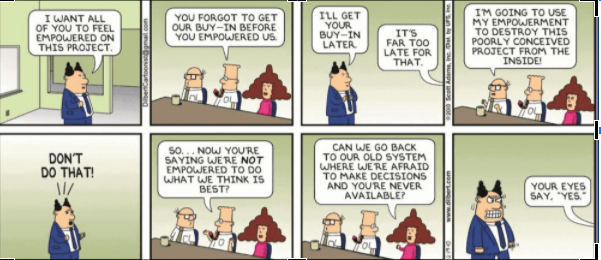How to Gain and Sustain Buy-In
Just because you built buy-in doesn’t mean it will stick around. It needs cultivation and invested time.


So often, we feel as though we have to keep our cards close to our chests as leaders. We don’t want scrutiny. We worry that the plan has to be perfect—which doesn’t exist—before we reveal it. Maybe there’s a lack of trust within our Team. Perhaps we think our Team isn’t capable of thinking at our level. Or, we’re worried that our Team is not ready for change so we prolong telling them about it until the plan is done and it needs to be executed immediately.
The best way to gain buy-in? Put your people first and treat them as professionals. How do you do that? You bring them to the table. You give them the confidence to provide valuable feedback. When you have time to do so, getting people to contribute their ideas before you make a decision allows you to adopt some or all of them and increase buy-in. Gaining their ideas in advance is more plausible than gaining feedback from them after you’ve made a decision. When you make this practice a habit, then people will better understand the times when you need to make an immediate decision.
How to gain organizational buy-in:
- Trust – Be authentic and vulnerable. Your Team is better together. One-on-one meetings and small team meetings are great ways to foster this trust.
- Psychologically safe environment – practice empathy and compassion and create a space where everyone can have a voice.
- Request input and feedback – Ask specific questions and really address your Team’s concerns—allow everyone to speak. Don’t be overly attached to ideas.
How to get buy-in for an idea:
- The “WOW” factor – Let your Team know how this is going to positively impact them and the organization.
- Share your journey on developing this plan – Tell them why you think this is the best one. Bring data to the table for your operational thinkers. Share examples of success. Use storytelling. Use “what if we did nothing?” or “what else could we do?” scenarios so that your team can see why this is the best way forward.
- Ask for input and feedback early and often – Tell your Team that you’re still in the brainstorming stages and you want them to poke holes in the current plan.
Once you have buy-in, how do you keep it?
- Communicate often – Clarify timelines, keep your direct reports and the Team updated on the progress. Document your various steps along the way on an open forum.
- Establish ownership – Use “we” and “us” when discussing the Team and the plan. These simple words will spread buy-in and a sense of belonging.
- Celebrate wins – Give credit to others when things go well. Take ownership of pitfalls.
What happens when you get crickets in a meeting? It could be one of three things.
- Processing time – Make sure you are speaking at the speed of trust. Sometimes too much information can be overwhelming and people shut down.
- Fear – They don’t want to pop your balloon, they don’t want to look stupid, they may have been burned in the past, or they are afraid of speaking up. You can eliminate most of the fear by developing trust and psychological safety.
- Indifference – They may be thinking, why fix it if it isn’t broken, we’ve always done it this way, we’ve tried that before, what can I do anyways, or glad I’m not at the helm! These statements are in contrast with continuous improvement. Don’t let your Team drift with these negative mind frames.
“Great things in business are never done by one person. They’re done by a team of people.” ~ Steve Jobs
Do you have newly promoted leaders that you want to thrive and master their added responsibilities and challenges? Then the Lead Well program is perfect for them. SIGN UP NOW by booking a free 30-minute consultation with Laura! Only a few spots left. The next session starts in the beginning of February!
J



